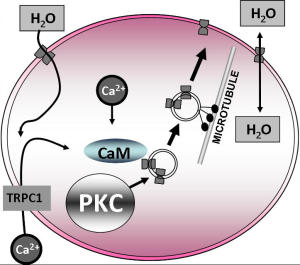Scientists at Aston University (UK) have identified a new mechanism responsible for regulating the flow of water into and out of cells. This discovery will improve understanding of how the body maintains its water balance in health and disease.

A model for the direct regulation of rapid cellular water flow. (Credit: Image courtesy of Aston University)
Proteins called aquaporins (AQPs), which allow water flow into and out of cells were discovered by scientists in California, twenty years ago. These proteins, embedded in cell membranes, constitute the cellular ‘plumbing system’. However, the mechanism which regulates their function under different conditions has remained unclear for many years, such as the control of water flow in the kidney. Now, a research team, led by Dr Roslyn Bill, Director – Aston Research Centre for Healthy Ageing, has discovered that the abundance of AQPs in the cell membrane can be increased or decreased in response to a change in water availability. A key finding is that water, within a few seconds triggers the movement of AQPs from vesicles inside the cell, to the membrane. Here the newly delivered AQPs act to increase the flow of water.
Dr Bill, a Reader in Molecular Biology, said; “The average water content of the human body is approximately 60%, while the water content within individual cells of different tissues is highly diverse, ranging from about 10% in fat to 75% in muscle. Consequently, cellular water flow needs to be tightly regulated in order to maintain this situation.
“The wide range of tissues that are known to express AQPs is reflected by their involvement in many physiological processes and diseases. Understanding the regulation of AQP function therefore has the potential to provide new avenues for developing highly specific drugs.”
Source: http://www.sciencedaily.com/
Dear User/Visitor! Please, answer on our questions: tick off one of the positions – your answer will make us able to improve our site and make it more interesting and useful!

